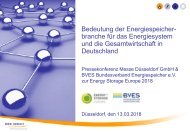Renewable Energy – Solutions for application in the communal energy infrastructure
This brochure contains a selection of successful renewable energy solutions suitable for a range of applications for local and national municipalities and economies. The main energy end-use sectors and the current state of the energy transition are briefly explained to provide readers with an understanding of the transformation of the greater energy system. The renewable energy technology options are explained, including their relevance and applications for municipalities. Finally, a selection of exemplary projects that have been successfully implemented in Europe, the Russian Federation and Central Asia, are included to demonstrate real applications and use-cases for renewable solutions. Renewable energies are cheap, clean and versatile.
This brochure contains a selection of successful renewable energy solutions suitable for a range of applications for local and national municipalities and economies. The main energy end-use sectors and the current state of the energy transition are briefly explained to provide readers with an understanding of the transformation of the greater energy system. The renewable energy technology options are explained, including their relevance and applications for municipalities. Finally, a selection of exemplary projects that have been successfully implemented in Europe, the Russian Federation and Central Asia, are included to demonstrate real applications and use-cases for renewable solutions. Renewable energies are cheap, clean and versatile.
You also want an ePaper? Increase the reach of your titles
YUMPU automatically turns print PDFs into web optimized ePapers that Google loves.
EXAMPLE PROJECTS |<br />
35<br />
Germany: Modernisation of a small hydropower plant<br />
The hydroelectric power plant on <strong>the</strong> Möhne River has been <strong>in</strong> operation s<strong>in</strong>ce 1906 and today produces 2.2 million kilowatt hours of<br />
electricity annually.<br />
Decentralised electricity<br />
generation from hydropower<br />
has a centuries-old<br />
tradition.<br />
That is why many hydropower<br />
plants have been <strong>in</strong><br />
operation <strong>for</strong> decades.<br />
When <strong>the</strong> time comes <strong>for</strong><br />
modernisation, it is<br />
advisable to also improve<br />
<strong>the</strong> protection of fish and<br />
water bodies. This was<br />
also <strong>the</strong> case with <strong>the</strong> plant <strong>in</strong> Himmelp<strong>for</strong>ten <strong>in</strong> North<br />
Rh<strong>in</strong>e-Westphalia.<br />
Several measures also improved <strong>the</strong> level of environmental<br />
friendl<strong>in</strong>ess and conditions <strong>for</strong> fish stocks. For<br />
example, <strong>the</strong> rake distances were reduced so that <strong>the</strong><br />
fish do not swim <strong>in</strong>to <strong>the</strong> turb<strong>in</strong>es. They reach <strong>the</strong>ir<br />
spawn<strong>in</strong>g grounds via a new device known colloquially<br />
as a “fish ladder”.<br />
In 1906, <strong>the</strong> diversion power plant <strong>in</strong> <strong>the</strong> river Möhne<br />
was put <strong>in</strong>to operation <strong>for</strong> <strong>the</strong> first time. It has been<br />
generat<strong>in</strong>g electricity with two turb<strong>in</strong>es ever s<strong>in</strong>ce.<br />
After more than 100 years of operation, <strong>the</strong> hydropower<br />
plant was to be modernised. A Kaplan tubular turb<strong>in</strong>e<br />
with 600 kilowatts of power was <strong>in</strong>stalled, which went<br />
<strong>in</strong>to operation at <strong>the</strong> beg<strong>in</strong>n<strong>in</strong>g of 2012. The highly<br />
efficient plant generates around 2.2 million kilowatt<br />
hours of electricity per year. That is a third more than<br />
The new Kaplan tubular turb<strong>in</strong>e with 600 kilowatts of power.<br />
be<strong>for</strong>e and enough <strong>for</strong> 624 households. The annual CO 2<br />
avoidance amounts to 900 tonnes.








